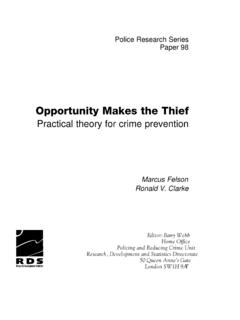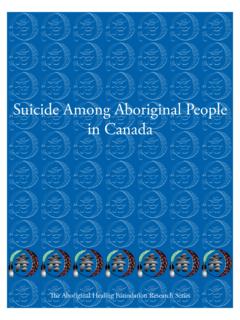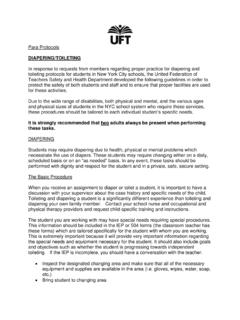Transcription of TRADITIONAL MAORI PARENTING - Mana Ririki
1 TRADITIONAL MAORI PARENTING An Historical Review of Literature of TRADITIONAL MAORI child rearing practices in Pre-European Times Professor Kuni Jenkins, PhD. Helen Mountain Harte Te Kahui Mana Ririki . Auckland, New Zealand. May 2011 ii Published by Te Kahui Mana Ririki , Auckland, New Zealand May 2011 This publication was prepared by Te Kahui Mana Ririki , with funding from the Office of the Children s Commissioner. The opinions expressed in this report do not necessarily reflect the official views, opinions or position of the Children s Commissioner. iii Karakia Whakatuwheratanga Toitu te rangi Toitu te whenua Toitu te aroha o te Atua Toitu ona manaakitanga katoa Mauriora e Te Ariki Matua, Tama, Wairua Tapu. Amine. iv Whakapuakitanga/Foreword When I read these research findings I immediately think of the opening stanza of the Ode to Immortality, by William Wordsworth: The child is but father of the man, And I could wish my days to be In such natural piety.
2 We cannot turn back the clock but we can redeem the present by looking to the past; and glean from it lessons that might give us all a better sense of what is possible in the arena of PARENTING . The research done by my whanaunga and colleagues captures images that we could well emulate as we struggle to find answers to an ever increasing circle of seemingly unstoppable violence to our children. The history revealed tells us it is possible, all we need is the will to achieve. One of our tasks as Te Kahui Mana Ririki has been to dig deep into our own reo and mine the riches that are there and from them espouse a philosophy that engenders hope and confidence. What we present here is not definitive but it is hoped that others might add further to what we have begun.
3 I would like to thank the Office of the Children s Commissioner for funding this research and supporting the development and helping to rejuvenate MAORI practices that have relevance today. These values have the power to help us parent in a way that supports our children to reach their full potential. Dr Hone Kaa. Chair, Te Kahui Mana Ririki . v Message from the Children s Commissioner I welcome this historical review of the literature on MAORI PARENTING practices in pre-European times. It was conceived in discussions with leaders of Te Kahui Mana Ririki on the different and varied beliefs and practices about children, childhood and PARENTING that helped to shape contemporary New Zealand views. We thought it would be useful to document the MAORI heritage of PARENTING practices .
4 What we have received in this brief report is a rich and well-referenced picture of pre-European practice amongst MAORI . I hope it will provide, as Dr Hone Kaa writes here, an impetus for all New Zealanders to learn from this heritage how children might be treated with love and respect. I join in thanking the authors for their work. Dr John Angus Children s Commissioner March 2011 vi He Whakamihi/Acknowledgements We wish to thank the kuia, kaumatua and health providers who helped with this literature review. We thank the Office of Children s Commissioner for the opportunity to conduct this review project. Peer reviews Dr Khyla Russell, Otago Polytech. July 2010 From the outset the document is tuturu in its representation as well as its presentation to the reader. The first section is nicely wrapped up into a neat package on page six where the reviewers interpretations are clear, informative and fit with aspects with which this reader is familiar as well as many which, as a reader I am enjoying as presented in a new way.
5 In some instances the descriptions are new to my understandings. Tikanga Whakatipu Ririki PARENTING model was developed by Helen Harte arising out of the purakau and waiata. She and Jenkins have written a seminal piece of work whose conclusion on p 28 more succinctly than I, has summed up the state of our tamariki mokopuna who are victims of abuse. The models and guides on good PARENTING are clear, easy to follow whilst still being crafted and couched in academic terms in a manner that makes this one of the best and most informative annotated reviews I have read. It has been a delight and pleasure to comment on. He mihi nunui ki a k rua mo tou k rua tuhika hohonu. Robert M Newsome BMS, Lecturer in MAORI Spirituality and Theology. August 2010. In beginning with karakia, and the acknowledgement of Tupuna and nga taonga tuku iho the review sets the right wairua in place.
6 Vii MAORI mythology and traditions provide myth messages to which MAORI people can and will respond today. Atua and persons, both male and female are shown in their roles, and with tupuna stories, offer directions for behaviour. The authors are commended for an in depth literature review. I recommend the Tikanga Whakatipu Ririki PARENTING model for MAORI parents today. Dr Hone Kaa, Lecturer St John s College. August 2010 The research done by our colleagues captures images that we could well emulate as we struggle to find answers to an ever increasing circle of seemingly unstoppable violence to our children. viii Table of contents Published by Te Kahui Mana Ririki , Auckland, New March Message from the Children s He Peer Table of Whakarapopotanga/Executive Te take o te ripoata/The purpose of the Effects of the tipuna on the primal Hinetitama as a whanau Maui as a whanau A template is created for the human The TRADITIONAL MAORI Section 1.
7 Literature PARENTING in the Nga Matua Purakau/ PARENTING in the The Primal Nga Matua Tuatahi / The First ix Nga Wahine Atua / The Primal Female Nga Tane Atua / Men as Primal Male Te Whanau o Maui / Maui s Hei hoa tane, matua a Maui / Maui as a husband and child rearing messages signposted from the Section 2. Nga Ririki / The Te Whanautanga mai/From the Nga Kawa/The Waiata Analysis of Section 3. Nga Tauiwi Tirotiro/The The observations of the tipuna raising Earliest observed child rearing Section 4. Tikanga Whakatipu Ririki /The MAORI PARENTING Tikanga Whakatipu Review x Whakarapopotanga/Executive abstract This report is based on a review of literature exploring MAORI PARENTING practices and the philosophy supporting these practices before 1642.
8 This knowledge can be found in the whakapapa, the tipuna (ancestral) links to the spiritual world, the purakau (oral histories), the waiata oriori (lullabies), whakatauki (proverbs), and nga korero iwi (tribal stories). In all of this literature, the tikanga (rules, custom, methods) of PARENTING are signposted. The fundamental principle for raising children was the underlying belief that children were favoured as gifts from the atua (spiritual beings), from the tipuna (ancestors) and preceded those unborn, which meant that they were tapu (under special rules and restrictions). Any negativity expressed to them was breaking the tapu by offending the atua and the tipuna gone before. Because of their intrinsic relationship to these spiritual worlds, the children inherited their mana (power, prestige).
9 They were treated with loving care (aroha) and indulgence. Punitive discipline in whatever degree, as a method of socialising children, was an anathema to the tipuna. Te take o te ripoata/The purpose of the report The purpose of this report is to research the TRADITIONAL , pre-European settlement, MAORI child rearing and PARENTING practices , with particular reference to socialisation and discipline. The research will show how these practices might form or do form the basis for a 21st century kaupapa of PARENTING for MAORI and potentially for other New Zealanders. This review has revealed the MAORI system of PARENTING and the philosophy behind it. The values of the tipuna are fundamental to any PARENTING today. These strengths are the base of the PARENTING model developed by Te Kahui Mana Ririki for use with whanau today.
10 This literature review is in three sections. The first section investigates the purakau for the cultural messages of child rearing contained therein. Section Two discusses the child rearing thoughts underlying child rearing and PARENTING in some of the TRADITIONAL oral literature about birthing ceremonies and the waiata oriori. These had positive effects on children, and adults xi and reinforced cultural beliefs. Section Three discusses the observations filtered through the minds of the first Europeans who saw PARENTING by our tupuna in some communities. The TRADITIONAL PARENTING methods are summarised. In Section Four, the research findings, are related to the development of the PARENTING model, Tikanga Whakatipu Ririki .




